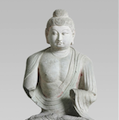GALLERY 1610 | BUDDHIST SCULPTURE
 In the late sixth century BCE, the northern Indian prince Siddhartha Gautama chose to abandon a life of worldly pleasure. He sought release from the suffering he believed inherent in samsara, the cycle of birth, death, and rebirth. Awakening to an understanding of existential suffering, he became the historical Buddha Shakyamuni, and his teachings, which offered both insights into samsara and a means to escape from it, became the basis of the philosophical and religious system now called Buddhism.
In the late sixth century BCE, the northern Indian prince Siddhartha Gautama chose to abandon a life of worldly pleasure. He sought release from the suffering he believed inherent in samsara, the cycle of birth, death, and rebirth. Awakening to an understanding of existential suffering, he became the historical Buddha Shakyamuni, and his teachings, which offered both insights into samsara and a means to escape from it, became the basis of the philosophical and religious system now called Buddhism.
The religion’s earliest adherents believed the Buddha—literally, the “Awakened One”—to be a perfected mortal whose exemplary life of right living, proper meditation, and compassion demonstrated the path to awakening. Within three hundred years after the Buddha’s death, however, a new form of Buddhism arose. Mahayana Buddhism understood the Buddha as but one of many buddhas and posited the existence of numerous other deities—the most important of which are bodhisattvas, awakened beings who have postponed their release from samsara in order to aid their supplicants. By the first several centuries of the common era, Mahayana Buddhism came to flourish in East Asia, becoming one of the most important creative sources for art and architecture in China, Korea, and Japan.
In medieval East Asia, Buddhism was often referred to as the “teaching of images,” and it was primarily through the exchange of portable images, both painted and sculpted, that the religion was transmitted to the region. In Buddhist ritual practice, painted or sculpted images are treated not as representations of deities but as living deities themselves.
The works in this gallery are among the finest Chinese and Korean Buddhist sculptures in any American collection. They are drawn largely from the collection of Grenville L. Winthrop (1864–1943), a Harvard graduate of eclectic aesthetic predilections who held a special interest in early Chinese art.
November 16, 2014 (Inaugural) – present




